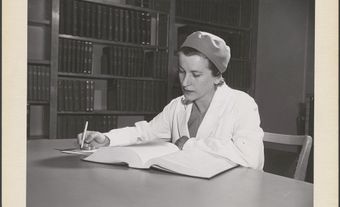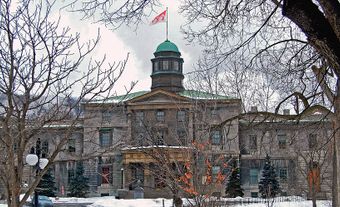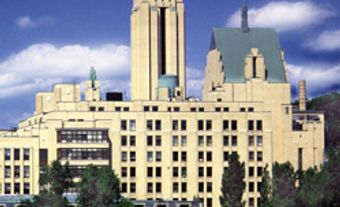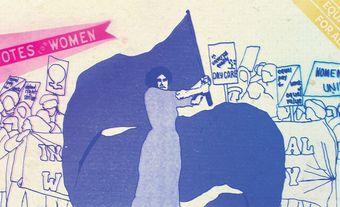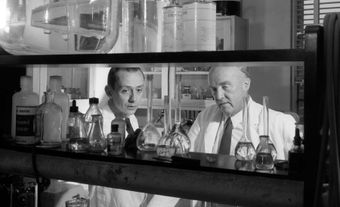Brenda Atkinson Milner (née Langford), CC, GOQ, FRSC, FRS, neuropsychologist (born 15 July 1918 in Manchester, England). Dr. Milner pioneered the field of neuropsychology, combining neurology and psychology. Most notably, she discovered that the part of the brain called the medial temporal lobe (which includes the hippocampus) is critical for the forming of long-term memories. Milner’s later work revealed that the learning of skills involving the combination of vision and movement is not part of the medial temporal lobe system. These discoveries proved that there are different forms of memory in different brain regions. Through her observation of patients, Milner changed forever our understanding of the brain’s learning and memory mechanisms.
Click here for definitions of key terms used in this article.

Early Life and Education
Brenda Milner was born to pianist and music critic Samuel Langford and his wife, Leslie Doig, who had been Samuel’s singing student. Milner and her mother both survived cases of influenza during the 1918 pandemic.
Milner spent her early years surrounded by musical influence. Homeschooled, she learned the classics from her father and French from her mother. At the age of eight, Milner lost her father to tuberculosis. She then entered Withington Girls’ School where she discovered her love of mathematics. In 1936, she received a Manchester City Scholarship to study math at Newnham college, Cambridge University.
Milner soon realized that she would not be a great mathematician. On the advice of senior faculty in Cambridge’s Department of Psychology, she transferred to psychology. Working with experimental psychologist Oliver Zangwill, Milner developed an interest in the effects of brain injury on behaviour. She graduated with a BA in 1939.
With a two-year grant from Newnham College, Milner started to research how people respond to sensory misinformation (e.g., when one’s sense of sight seems to disagree with one’s sense of movement). However, with the arrival of the Second World War, her studies were diverted toward the war effort. She began developing and running aptitude tests on air force recruits. These tests helped to decide which recruits would be fighter pilots and which would be bomber pilots.
Career Highlights
When her grant ran out in 1941, Brenda Milner began a role at the UK’s Ministry of Supply. Her job was to investigate which displays and controls were most intuitive for radar operators. There, she met her future husband, electrical engineer Peter Milner.
In 1944, Peter Milner joined a group of scientists on a one-year program to develop atomic research in Canada. The couple got married and, within two weeks, left for their new home in Montreal, Quebec.
Brenda Milner accepted her first academic job at the Institut de psychologie at Université de Montréal, where she taught in French. In 1950, she began a PhD at McGill University under Donald Hebb’s direction. She began researching how people who are congenitally blind use touch to form their concept of the external world. However, Milner’s focus changed when she was invited to collaborate with Wilder Penfield. She began performing psychological tests and analyzing data from patients with epilepsy before and after the surgical removal of parts of their brains. Her goal was to determine the effect of these surgeries on behaviour. Milner obtained her PhD in physiological psychology in 1952.
After graduating, Milner was offered a position by Wilder Penfield at the Montreal Neurological Institute. There, she continued her work on the behavioural effects of temporal lobe surgeries. Milner and Penfield presented results from their work with P.B. and F.C., two patients with post-surgical amnesia, at the 1955 meeting of the American Neurological Association. Neurosurgeon William Scoville from Connecticut contacted them after the presentation. He had seen similar memory troubles in his patient known as H.M., later the subject of Milner’s biggest discovery. (See Key Discoveries.)
By 1964, the Medical Research Council of Canada supported Milner both through a Career Investigator Award for her salary and separate funding for her research. During this period, she pioneered the field of neuropsychology, bringing together the fields of neurology and psychology. In 1990, she stepped down as director of neuropsychology at the Montreal Neurological Institute to focus on her research.
Key Discoveries

In the 1950s, scientists believed that the processes of learning and memory required use of the entire brain. Brenda Milner’s studies involving the surgery patient known as H.M. disproved this view and changed our understanding of the brain.
In 1953, neurosurgeon William Scoville removed the medial temporal lobe of H.M.’s brain to halt debilitating epileptic seizures. As a result, H.M. suffered from anterograde amnesia. This meant that he could no longer convert his short-term memories into long-term ones, a process known as memory consolidation. Penfield and Scoville invited Milner to perform psychological testing to assess H.M.’s learning and memory. She observed that while H.M. could remember enough from moment to moment to hold a conversation, he would forget events that had taken place minutes before. This allowed Milner to prove that memory consolidation occurs in the medial temporal lobe system.
Milner continued to assess H.M. In 1962, she designed an experiment to examine his learning of motor skills. Her breakthrough was that even though he had memory problems, he was still able to learn new motor skills. This meant that the learning of motor skills was not part of the medial temporal lobe system. However, H.M. could not remember having learned the skills from Milner’s experiments. This was the key evidence demonstrating that there is more than one memory system in the brain.
Milner’s studies with H.M. continued for over 30 years. She thought of him as a good friend even though every time they met, he did not know her.
Milner made other key discoveries about the effects of brain injuries on cognitive functions. In 1963, using the Wisconsin Card Sorting Test, she found that patients with frontal lobe damage were unable to adapt to a change in task instructions (regardless of whether the lesion was located on the right or left hemisphere). Her later research showed that language function can reorganize across the brain’s hemispheres after brain injury (a process known as lateralization). She also studied problem-solving difficulties caused by frontal and temporal lobe injuries. Here, she observed that patients with frontal lobe damage had increased risk-taking tendencies. Additionally, both left frontal and temporal lobe damage caused difficulty with language interpretation. These phenomena were independent of intelligence levels, which the injuries did not affect.
Later Life
Brenda Milner continued to supervise and carry out research at McGill well into her nineties. A two-day symposium at McGill celebrated her 100th birthday in 2018. In 2019, a school in Chateauguay, Quebec, was named in her honour. She remains on faculty at McGill as the Dorothy J. Killam professor.
Honours and Awards
Brenda Milner is among the most decorated scientists in Canadian history. Throughout her career, she has received more than 25 honorary degrees and 90 awards celebrating her work. These include:
- Fellow, Royal Society of Canada (1976)
- Member, National Academy of Sciences (1976)
- Fellow, Royal Society of London (1979)
- Killam Prize for Health Sciences, Canada Council for the Arts (1983)
- Prix Wilder-Penfield (Prix du Québec) (1993)
- McLaughlin Medal, Royal Society of Canada (1995)
- Inductee, Canadian Medical Hall of Fame (1997)
- National Academy of Sciences Award in Neurosciences (2004)
- Companion, Order of Canada (2004)
- Gairdner Foundation International Award in Health Research (2005)
- Balzan Prize for Cognitive Neurosciences (2009)
- Grand Officer, National Order of Quebec (2009)
- Kavli Prize in Neuroscience (2014)
- Medal for Exceptional Academic Achievement, McGill University (2017)
- Medal of Honour, National Assembly of Quebec (2018)
- Inductee, Canada’s Walk of Fame (2023)

 Share on Facebook
Share on Facebook Share on X
Share on X Share by Email
Share by Email Share on Google Classroom
Share on Google Classroom
